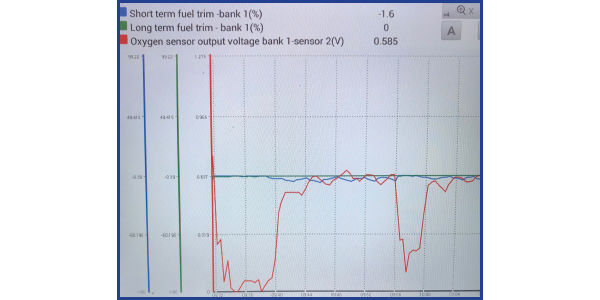
The best way to understand fuel trims is to compare how a carbureted engine and fuel-injected engine handle a cold start. Carburetors have jets with fixed-sized fuel holes and venturies. During a cold engine start, a carburetor will block off the air to a venturi with a choke. By reducing the airflow, the mixture becomes richer. This changes the air/fuel mixture to a rich state for a cold start.
Fuel-injected engines can adjust the fuel trim by altering the injector open time. The longer the open-time of the injector, the greater amount of fuel is injected into the engine.
The engine management system must measure or estimate the air passing the intake valves and look at the oxygen content in the exhaust gases to calculate the optimal injector open time. This is where fuel trims come into play as a diagnostic tool.
What are Fuel Trims?
Fuel trim is the adjustment the engine computer makes to the fuel mixture to maintain a balanced air/fuel ratio. Fuel trim is usually displayed as a percentage reading on a scan tool. The percentage is not related to an exact measurement of fuel or air, so the engine runs at the desired stoichiometric value.
A rich fuel mixture can produce more power (up to a point), but it also increases fuel consumption and emissions. Conversely, a lean fuel mixture can reduce fuel consumption.
Accurate fuel trim values require precise information from the oxygen sensor and other sensors. If the information is inaccurate, the engine computer has no way of knowing whether the fuel mixture too running rich or lean. When the engine is shut off, the fuel trim values are retained in the computer’s memory so the next time the vehicle is driven, it can pick up where it left off when it goes into closed-loop operation when the oxygen sensors are at operating temperature. It is possible to clear the learned fuel trim values with a scan tool or by disconnecting the battery.
How to Read Fuel Trim
The engine should be started and running to read the fuel trim information. Most fuel trims are expressed as percentages. A positive value typically indicates fuel is being added to reach the desired air/fuel ratio. A negative fuel trim shows fuel is being taken away to achieve the desired air/fuel ratio. Most fuel trims data PIDS can be read using the global OBDII function of your scan tool. There will be two fuel trim values for each bank of the engine.
Short-Term Fuel Trim (STFT) values change rapidly and can bounce around quite a bit depending on engine load, speed, temperature and other operating conditions. Values typically range from -10% to +10%, though the readings may jump as much as 25% or more in either direction depending on load, throttle position and engine speed.
Long-Term Fuel Trim (LTFT) is a longer-term average of what the engine computer has been doing to balance the fuel mixture over a predetermined interval of time. This value is a more accurate indicator of how the fuel mixture is being corrected to compensate for changes in the air/fuel ratio that are occurring inside the engine. The long-term fuel trim can vary depending on the altitude. If the LTFT pegs too high or low, the engine control module will set a code and take other actions to save the engine and catalytic converters.

Negative Fuel Trims
A negative fuel trim indicates the fuel is being taken away or being leaned out because the engine is running rich. A leaking fuel injector could cause a rich condition. Or, the rich condition could be caused by a restriction or disruption that prevents air from reaching the cylinder.
Positive Fuel Trim

Positive fuel trim diagnostics are a little more complicated. If an air filter or air induction system is delivering more than the normal amount of air, it will cause the oxygen sensor to detect a lean condition. It will add more fuel and cause the fuel trim to be positive. Unmetered air is typically the cause of positive fuel trims. Unmetered air can enter into the engine through leaks in the intake manifold or positive crankcase ventilation system.
Fuel Trim and Sensors
Fuel trim numbers on their own can only tell you so much. Visual inspection is the first step in diagnosing fuel trim problem. Disconnected vacuum hoses or a damaged air filter housing can change the fuel trims. Also, a clogged air filter can change the fuel trim percentages.
The next area to look at are the sensors that measure fuel trim and control the open time of the injectors. The fuel trim numbers are a product of the sensors. If the oxygen sensor is under or over-reporting the oxygen content in the exhaust gases, it will change the fuel trim numbers. Also, if a mass airflow sensor or manifold air pressure sensor is under or over-reporting, these are going to change the fuel trim values. Low fuel pressure from the pump can cause a positive fuel trim number because it can reduce the fuel delivered by an injector when it is open.













